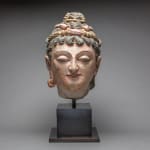Gandharan Stucco Head of a Bodhisattva, 100 CE - 400 CE
Stucco
height 33 cm
height 13 in
height 13 in
AM.0215
Further images
Gandhara’s geographical position, situated between the Persian world to the west and the Indian to the east, ensured that it was open to a wide variety of artistic influences. Often...
Gandhara’s geographical position, situated between the Persian world to the west and the Indian to the east, ensured that it was open to a wide variety of artistic influences. Often described as a ‘cultural melting pot,’ its strategic importance left it vulnerable to attack. Briefly in the hands of Alexander the Great between 32 -326 B.C., Greek artistic conventions long played an important role in local production. However whilst Gandhara clearly came under the influence of an extraordinary wide range of outside influences, it was also an exporter of ideas. This is most apparent in relation to the spread of Buddhism from India into other parts of Asia. Gandharan monks and scribes were particularly active in areas of China. According to tradition Buddhism was first introduced into the Gandharan region under the patronage of Asoka, emperor of the Mauryan dynasty, in the third century B.C. The first significant physical remains to survive, including stupas and figurative sculpture, date from the first century B.C. Between c.100-400 A.D. sculptors working in schist, terracotta and stucco produced an astonishing number and variety of Buddhist images.
This stucco head is remarkable for the excellent condition of the original polychromy. Bodhisattvas were enlightened beings who delayed their own entry to Nirvana to help others to end the cycle of birth and rebirth. Although there is some damage to the left ear, the elongated earlobe is clearly visible on the figure’s right. Bodhisattvas were typically richly adorned in contrast to the modest apparel of the historical buddha who renounced his material wealth. This example is no exception; the surviving earring has been carefully moulded with an oval and stylised flower design. The most attractive feature however is the twisted cord which has been used to fix the curly hair in a top-knot. Three large red beads and small flowers make a pleasing contrast with the blue pigment used for the curls. The downward gaze, large almond shaped eyes and small mouth all contribute to the beauty of this piece.
This stucco head is remarkable for the excellent condition of the original polychromy. Bodhisattvas were enlightened beings who delayed their own entry to Nirvana to help others to end the cycle of birth and rebirth. Although there is some damage to the left ear, the elongated earlobe is clearly visible on the figure’s right. Bodhisattvas were typically richly adorned in contrast to the modest apparel of the historical buddha who renounced his material wealth. This example is no exception; the surviving earring has been carefully moulded with an oval and stylised flower design. The most attractive feature however is the twisted cord which has been used to fix the curly hair in a top-knot. Three large red beads and small flowers make a pleasing contrast with the blue pigment used for the curls. The downward gaze, large almond shaped eyes and small mouth all contribute to the beauty of this piece.







